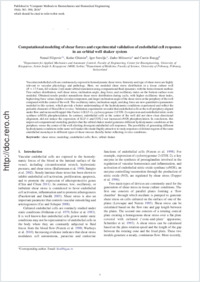Computational modeling of shear forces and experimental validation of endothelial cell responses in an orbital well shaker system
- Filipovic, Nenad Department for Applied Mechanics and Automatic Control, Faculty of Engineering, Center for Bioengineering, University of Kragujevac, Serbia
- Ghimire, Kedar Department of Medicine, Faculty of Science, University of Fribourg, Switzerland
- Saveljic, Igor Department for Applied Mechanics and Automatic Control, Faculty of Engineering, Center for Bioengineering, University of Kragujevac, Serbia
- Milosevic, Zarko Department for Applied Mechanics and Automatic Control, Faculty of Engineering, Center for Bioengineering, University of Kragujevac, Serbia
- Rüegg, Curzio Department of Medicine, Faculty of Science, University of Fribourg, Switzerland
-
25.04.2016
Published in:
- Computer Methods in Biomechanics and Biomedical Engineering. - 2016, vol. 19, no. 6, p. 581–590
English
Vascular endothelial cells are continuously exposed to hemodynamic shear stress. Intensity and type of shear stress are highly relevant to vascular physiology and pathology. Here, we modeled shear stress distribution in a tissue culture well (R = 17.5 mm, fill volume 2 ml) under orbital translation using computational fluid dynamics with the finite element method. Free surface distribution, wall shear stress, inclination angle, drag force, and oscillatory index on the bottom surface were modeled. Obtained results predict nonuniform shear stress distribution during cycle, with higher oscillatory shear index, higher drag force values, higher circular component, and larger inclination angle of the shear stress at the periphery of the well compared with the center of the well. The oscillatory index, inclination angle, and drag force are new quantitative parameters modeled in this system, which provide a better understanding of the hydrodynamic conditions experienced and reflect the pulsatile character of blood flow in vivo. Validation experiments revealed that endothelial cells at the well periphery aligned under flow and increased Kruppel-like Factor 4 (KLF-4), cyclooxygenase-2 (COX-2) expression and endothelial nitric oxide synthase (eNOS) phosphorylation. In contrast, endothelial cells at the center of the well did not show clear directional alignment, did not induce the expression of KLF-4 and COX-2 nor increased eNOS phosphorylation. In conclusion, this improved computational modeling predicts that the orbital shaker model generates different hydrodynamic conditions at the periphery versus the center of the well eliciting divergent endothelial cell responses. The possibility of generating different hydrodynamic conditions in the same well makes this model highly attractive to study responses of distinct regions of the same endothelial monolayer to different types of shear stresses thereby better reflecting in vivo conditions.
- Faculty
- Faculté des sciences et de médecine
- Department
- Médecine 3ème année
- Language
-
- English
- Classification
- Biological sciences
- License
-
License undefined
- Identifiers
-
- RERO DOC 258961
- DOI 10.1080/10255842.2015.1051973
- Persistent URL
- https://folia.unifr.ch/unifr/documents/304747
Statistics
Document views: 103
File downloads:
- pdf: 375
